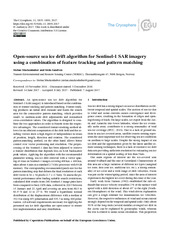Open-source sea ice drift algorithm for Sentinel-1 SAR imagery using a combination of feature tracking and pattern matching
Peer reviewed, Journal article
Published version

Åpne
Permanent lenke
https://hdl.handle.net/1956/17058Utgivelsesdato
2017-08-07Metadata
Vis full innførselSamlinger
- Geophysical Institute [1187]
Originalversjon
https://doi.org/10.5194/tc-11-1835-2017Sammendrag
An open-source sea ice drift algorithm for Sentinel-1 SAR imagery is introduced based on the combination of feature tracking and pattern matching. Feature tracking produces an initial drift estimate and limits the search area for the consecutive pattern matching, which provides small- to medium-scale drift adjustments and normalised cross-correlation values. The algorithm is designed to combine the two approaches in order to benefit from the respective advantages. The considered feature-tracking method allows for an efficient computation of the drift field and the resulting vectors show a high degree of independence in terms of position, length, direction and rotation. The considered pattern-matching method, on the other hand, allows better control over vector positioning and resolution. The preprocessing of the Sentinel-1 data has been adjusted to retrieve a feature distribution that depends less on SAR backscatter peak values. Applying the algorithm with the recommended parameter setting, sea ice drift retrieval with a vector spacing of 4 km on Sentinel-1 images covering 400 km × 400 km, takes about 4 min on a standard 2.7 GHz processor with 8 GB memory. The corresponding recommended patch size for the pattern-matching step that defines the final resolution of each drift vector is 34 × 34 pixels (2.7 × 2.7 km). To assess the potential performance after finding suitable search restrictions, calculated drift results from 246 Sentinel-1 image pairs have been compared to buoy GPS data, collected in 2015 between 15 January and 22 April and covering an area from 80.5 to 83.5° N and 12 to 27° E. We found a logarithmic normal distribution of the displacement difference with a median at 352.9 m using HV polarisation and 535.7 m using HH polarisation. All software requirements necessary for applying the presented sea ice drift algorithm are open-source to ensure free implementation and easy distribution.
